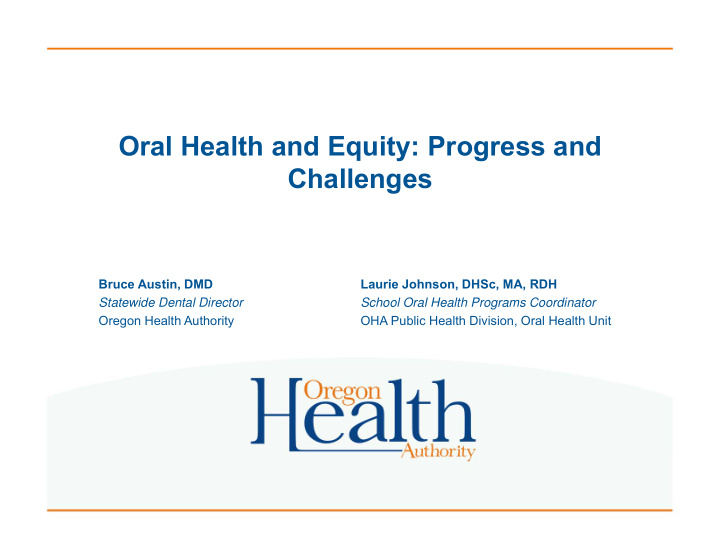



Oral Health and Equity: Progress and Challenges Bruce Austin, DMD Laurie Johnson, DHSc, MA, RDH Statewide Dental Director School Oral Health Programs Coordinator Oregon Health Authority OHA Public Health Division, Oral Health Unit
Oral Health Equity • Healthy People 2020 defines health equity as the: “attainment of the highest level of health for all people. Achieving health equity requires valuing everyone equally with focused and ongoing societal efforts to address avoidable inequalities, historical and contemporary injustices, and the elimination of health and health care disparities.” • Although the oral health of Americans has improved over the years, not everyone has the same opportunity to achieve optimal oral health. The situation worsens for those most vulnerable, especially children, people of color, and older adults.
Oral Health Equity • A just oral health care system is one that recognizes and accommodates different groups’ specific needs. • “Some people can make dental appointments during the weekday, but others can only go on nights or weekends.” • “Some people can hop in the car and drive to the local clinic, while others rely on buses and trains to get to faraway offices.” • “Some people know their dentist speaks their language, but others can’t make that assumption.” http://frameworksinstitute.org/toolkits/dentaquest/fr2.html
Video Link: https://player.vimeo.com/video/215557517
Racial & Ethnic Disparities
Age Disparities
Racial & Ethnic Disparities
Regional Disparities
Income Disparities
Access to Dental Care Children age 0-5 on OHP with any dental visit in 2016 80% Percent of enrolled children 60% 51% 50% 44% 40% 44% 44% 43% 39% 37% 36% 20% 0% Total African American Asian Hispanic/ Unknown Other Pacific White American Indian/ American Latino race Islander Alaska Native Notes: All other groups exclude Hispanic ethnicity. Source: DHS/OHA DSSURS Data Warehouse
Success: School Dental Sealant Programs
School Dental Sealant Programs • U.S. Community Preventive Services Task Force – a panel of independent health experts – recommends school sealant programs, citing “strong evidence of effectiveness” in reducing tooth decay among school-aged children. • Benefits of school sealant programs “exceed their costs when implemented in schools that have a large number of students at high risk for cavities.” U.S. Community Preventive Services Task Force. Preventing dental caries: School-based dental sealant delivery programs. 2013 April 2013. Retrieved from www.thecommunityguide.org/oral/schoolsealants.html.
School Dental Sealant Programs • Students who received dental sealants had a median of 50% fewer cavities up to four years later as compared with students who did not receive sealants. • Implementing a school sealant delivery program led to a 26% increase in the number of students who received sealants. Greater increases were seen among students from low-income families. Ahovuo-Saloranta A, Forss H, Walsh T, Hiiri A et al. Sealants for preventing dental decay in the permanent teeth. Cochrane database of systematic reviews . 2013;3:CD001830. U.S. Community Preventive Services Task Force. Preventing dental caries: School-based dental sealant delivery programs. 2013 April 2013. Retrieved from www.thecommunityguide.org/oral/schoolsealants.html.
Attention to Health Disparities • OHA Certification requires local school dental sealant programs to: – First target elementary and middle schools where at least 40% of the students are eligible for the federal free-and-reduced lunch (FRL) program before serving other schools. – Offer dental sealant services to all students with permission regardless of insurance status, race, ethnicity or socio-economic status.
Attention to Health Disparities • Piloting REALD questionnaire for OHA statewide schools in the 2017-18 school year – Only 20-25 schools
Training Dental Hygiene Workforce • Topics that have been added to the mandatory certification training and annual clinical training: – Health equity definitions – Cultural responsiveness – Workforce diversity – Health literacy – Plain language guidelines – Adverse Childhood Experiences (ACEs) – Trauma informed care practices
Challenge: Community Water Fluoridation
Community Water Fluoridation • Recognized as one of the 10 greatest public health achievements of the 20th century. • Community water fluoridation is simply the adjustment of existing fluoride in water to a level that helps prevent dental decay (cavities). – While fluoride occurs naturally in water, it is usually lower than the optimal concentration. • Oregon ranks 48 th among the states in percentage of residents who have access to optimally-fluoridated water.
Community Water Fluoridation Water Fluoridation in the U.S. & Oregon, 2010, 2012 & 2014 2010 2012 2014 Percentage of U.S. population on public 73.9% 74.6% 74.7% water systems receiving fluoridated water Percentage of Oregon population on public water systems receiving fluoridated 22.6% 22.6% 22.2% water Oregon fluoridation compared to other 48th 48th 48th states Source: CDC Water Fluoridation Reporting System and Oregon Drinking Water Services
Community Water Fluoridation • Evidence-based practice recommended by the Community Preventive Services Task Force, CDC, Association of State & Territorial Dental Directors, and Healthy People 2020. – Strong evidence that it is safe and improves oral health. • Population-based intervention, but is also a significant health equity intervention. • Proven to reduce dental cavities and disease across the entire population, regardless of age, race or ethnicity, insurance coverage, access to a dentist, or the ability to pay for care.
Current Activities • Only population-based intervention for oral health in the State Health Improvement Plan (SHIP). • PHD community water fluoridation workgroup meets every other month. – Strategic plan and communications plan has been developed. – Framing it in a positive, inclusive way that builds bridges • Developing educational materials on the different types of fluoride. • Updating the website for community water fluoridation.
Audience Question Who are the trusted messengers for educating communities about community water fluoridation?
Contacts Bruce W. Austin, DMD Statewide Dental Director Oregon Health Authority Phone: (503) 551-5905 Email: bruce.w.austin@state.or.us Laurie L. Johnson, DHSc, MA, RDH School Oral Health Programs Coordinator Phone: (971) 673-0339 Email: laurie.johnson@state.or.us
Recommend
More recommend